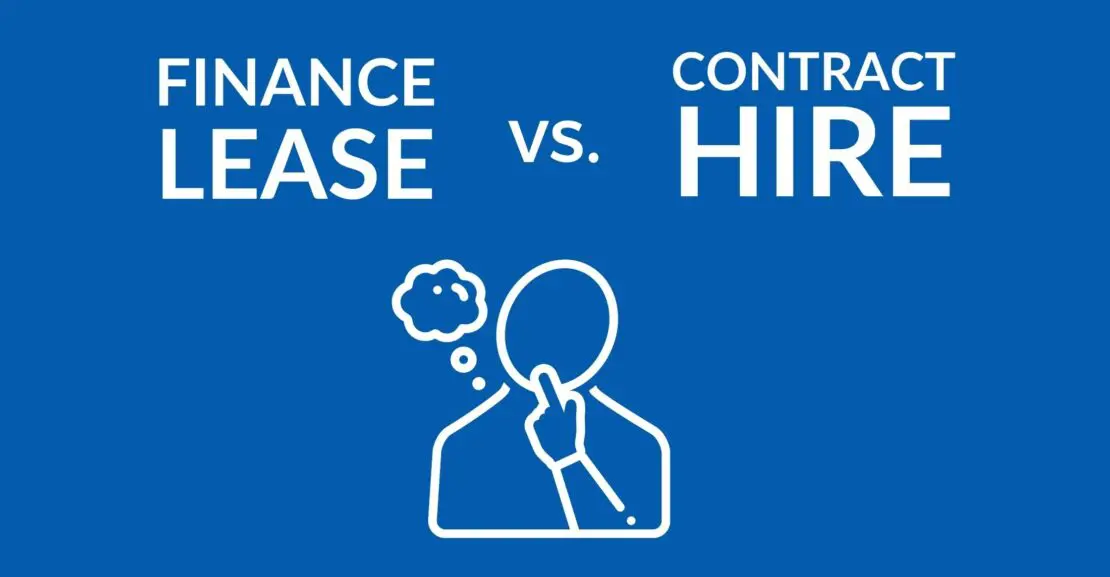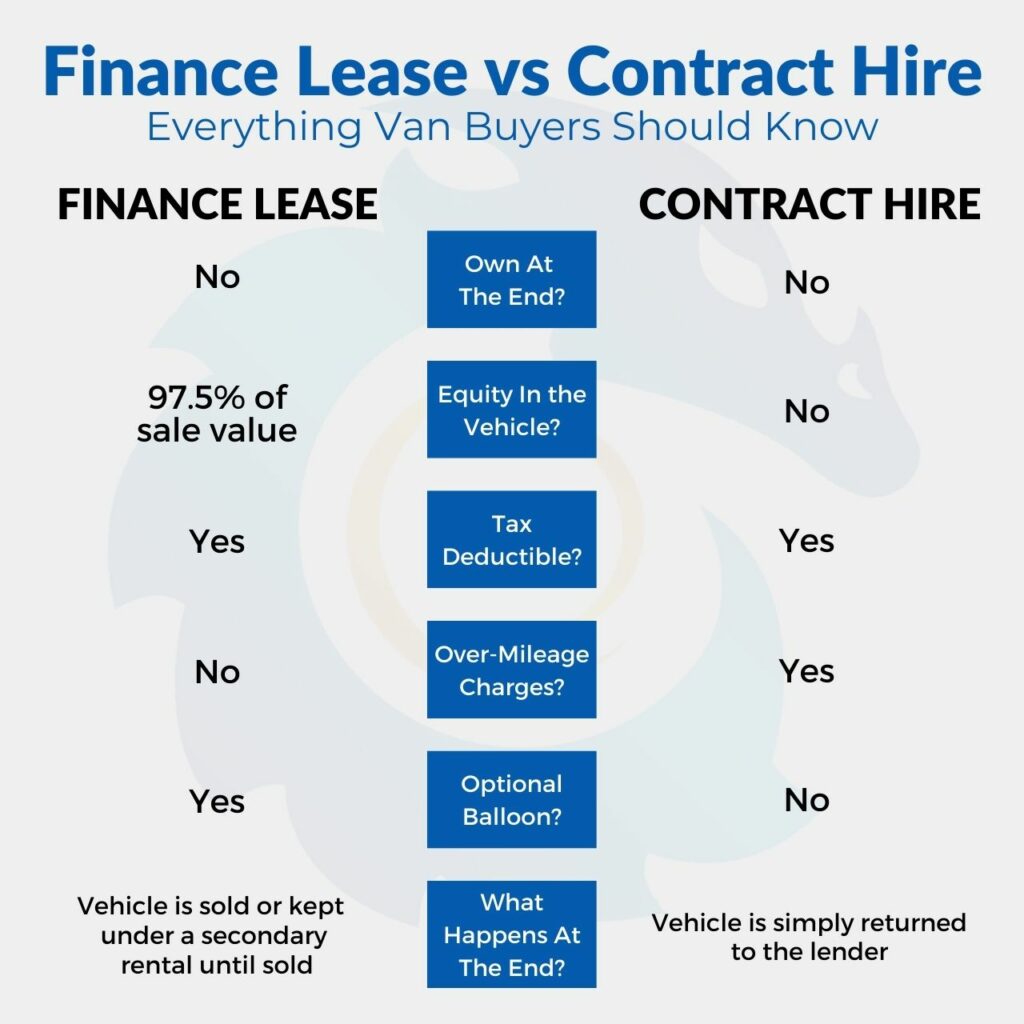Finance Lease vs Contract Hire: Which Is Right For You?
Finance lease vs contract hire: an age-old dilemma that confuses van buyers on a daily basis.
If you’re reading this, you’ve likely decided leasing is the right option for you.
But the leasing world can be tricky to navigate.
Between financial jargon, agreement structures and advertising small print, with leasing, it’s never been more important to know what you’re signing up for.
Contract hire and finance lease are the two main types of business leasing agreements dealerships and finance companies are able to offer.
Both fulfil a similar purpose in allowing you to benefit from having new vehicles at a lower monthly price.
However, they also feature some key differences vital for you to know before spending tens of thousands of pounds on a new vehicle.
In this guide, we’ll break down the key things you need to know about contract hire to help you decide which option is best for you.
Enough talk. Let’s get stuck in.
Looking To Lease A New Van? Click Here To Browse Our Full Inventory
What Is A Finance Lease?
A finance lease is a type of finance arrangement that spreads the cost of a new vehicle into affordable monthly payments.
Customers will pay an upfront deposit, followed by monthly repayments over an agreed term (usually 24-60 months) and an option for a balloon payment at the end.
The lender will set annual mileage limits to calculate how much the vehicle will be worth at the end of the term.
Then, they will set the sum of the balloon payment accordingly.
For instance: a van doing 5,000 miles per year will have a higher balloon than one doing 20,000 miles per year.
This is because the van is worth more at the end of the term due to having a lower mileage.
Therefore, finance companies can increase the balloon amount to reduce the customer’s monthly payments.
Do Finance Lease Agreements Have Over-Mileage Or Damage Charges?
With a finance lease, there are no over-mileage or damage charges.
However, any damage or excess mileage will affect the vehicle’s residual value.
It could determine whether you’ll be in positive or negative equity when paying off the balloon at the end.
It’s better to take care of your van regardless of the plan you choose.
Do You Own The Vehicle At The End Of A Finance Lease?
No. At least not all of it.
With a finance lease, the lender owns 2.5% of the vehicle.
So, when you come to sell it, you will need to give them 2.5% of however much you sell it for.
At the end of a finance lease, the balloon payment will automatically come out of your account. However, you can sell the vehicle prior to this, settle the balance and use any spare change to put towards your next one. Then, rinse and repeat.
Here’s an example of how it works:
Let’s say your finance period is coming to an end and your van is worth £10,000.
As per your agreement, there is a balloon payment due of £6,000.
First, you’ll need to pay the finance company 2.5% of £10,000 when you sell the vehicle – which is £250.
This leaves you with £9,750.
Once you settle the remaining finance and pay the £6,000 balloon, you’re left with £3,750.
Now you have £3,750 to do with as you please. Like, for example, using towards a deposit on your next van.
Advantages & Disadvantages Of Finance Lease
Advantages of Finance Lease:
- Drive a brand new vehicle at a lower monthly cost than hire purchase
- You do have some equity in the vehicle
- Any positive equity at the end can be used as a deposit on your next vehicle
- Flexible agreement periods: between 24 and 60 months.
- No over-mileage or damage charges
- Payments are tax-deductible
- You can settle the agreement at any point, but the lender may query this
Disadvantages of Finance Lease:
- You don’t own the vehicle at the end
- You can’t just hand the vehicle back at the end
- Mileage restrictions still apply
What Is Business Contract Hire?
Business contract hire is a van leasing option that operates very similarly to a long-term rental.
Customers will pay a deposit (known as an initial rental), followed by a series of monthly payments for a set term. These terms can range anywhere from 12 to 60 months.
At the end of the agreement, the vehicle is simply handed back to the finance company.
Annual mileage limitations will apply and you could be charged for exceeding them. You may also face charges for any damage to the vehicle when it’s returned.
Some packages even include service and maintenance, hence why many large fleet operators choose contract hire when leasing their vehicles.
Do You Own The Vehicle At The End Of A Business Contract Hire?
No. You do not have any equity in the vehicle whatsoever.
However, for some businesses, it might be more convenient to simply hand the vehicle back at the end of the agreement.
It all depends on what you want to get out of your agreement. If owning your vehicle at the end of the agreement sounds best for you, it’s worth looking into a hire purchase.
Advantages & Disadvantages Of Contract Hire
Advantages of Contract Hire:
- Drive a brand-new vehicle every couple of years
- You’re depreciating someone else’s asset, not your own
- Monthly payments are tax-deductible
- No balloon payments at the end
- No hassle with reselling the vehicle, simply hand it back at the end
- Flexible contract lengths: from 12 to 60 months
- Servicing packages can be included at an additional cost
Disadvantages of Contract Hire:
- No equity in the vehicle whatsoever, meaning you’ll not have any spare change coming back to use as a deposit for your next van
- Excess mileage and damage charges may apply
- Fees for terminating the agreement early may apply
- You won’t benefit from any increases in your vehicle’s market value
Finance Lease vs Contract Hire: Similarities & Differences
Similarities
New Vehicles At Lower Monthly Repayments
Both options give users access to brand new vehicles at lower monthly repayments than a hire purchase agreement.
Both Are Tax-Deductible
Both business contract hire and finance lease are tax deductible. This means you can offset your monthly repayments against any taxable profits throughout the whole term.
Both Offer Lower Initial Costs
With hire purchase agreements for businesses, customers are typically required to pay the full VAT upfront.
20% (at current VAT rates) of a brand new van is a lot of money.
However, finance lease and contract hire agreements spread the VAT throughout the term, meaning your upfront costs are lower.
You Can’t Own The Vehicle Outright With Either
Neither option allows you to own your vehicle outright.
However, with a finance lease, if you would like to continue using your vehicle after the end of your term, you can pay a secondary rental fee every year until you decide the sell it.
This is often known as a ‘Peppercorn Rental’.
Both Can Be Tailored To Suit Your Circumstances
Whether it’s the length of the term, annual mileage or deposit amounts, both types of agreements can be tailored to suit a host of business needs.
Differences
Finance Lease Can Include Balloons, Contract Hire Can’t
Finance lease agreements often include a balloon payment.
A balloon is a lump sum at the end of the agreement that allows for smaller monthly repayments throughout the term.
Contract hire agreements, on the other hand, do not have balloon payments.
Finance Leases Give You Equity, Contract Hires Don’t
As mentioned previously, with a finance lease agreement you keep 97.5% of the vehicle’s resale value, with the remaining 2.5% going back to the lender.
With contract hire, the vehicle is returned to the lender at the end of the term and the customer has no equity in the vehicle whatsoever.
Contract Hire Agreements Aren’t Affected By Market Fluctuations
Vehicle valuations fluctuate with time.
When demand is high and availability is scarce, vehicle prices will be higher. When demand is low and there’s an abundance of stock, prices will be lower.
When you come to sell your vehicle at the end of a finance lease agreement, you are at the mercy of this fluctuation.
Let’s use another example:
Say you purchase a van via a finance lease and the balloon payment is £8,000.
You’ve come to the end of your agreement and the market is strong. With 70,000 miles on the clock, your van has been valued at £12,000.
You pay 2.5% of £12,000 to the lender, leaving you with £11,700. Once you pay the balloon and settle the remaining finance, you’re now left with £3,700 to do with as you please.
Now, let’s use the above example, but in a weaker market.
Your agreement is coming to an end and you’ve also done 70,000 miles. But this time your van has been valued at £9,000.
You pay 2.5% to the finance company, leaving you with £8,775. This means once you’ve settled the remaining balance and balloon, you’re left with only £775.
That’s a difference of nearly £3,000 just because of changes in van valuations.
With contract hire, this isn’t a problem.
As there is no balloon payment and you return the vehicle back to the lender, you are not affected by the increase or decrease of your van’s value.
NOTE: At Vantastec, we make a conscious effort to keep balloon payments low. That way, there is a far greater chance of you having more money coming back to you at the end of your agreement.
Finance Lease or Contract Hire: Which Should You Pick?
So, that concludes our breakdown of finance lease vs contract hire.
Hopefully, you’ve come away from reading this more informed on the ins and outs of each agreement and are now ready to choose the best option for your business.
If you have any further questions or ideas for topics you’d like us to cover in the future, please feel free to leave a comment below!
For more help on van financing and buying, be sure to check out our full collection of guides and helpful content today.
Take care, all! We’ll catch you in the next one.
Read Next:
- 7 Best Refrigerated Vans To Buy In 2025
- Finance Lease vs Hire Purchase: Which Is Right For You?
- How Van Leasing Works At Vantastec




